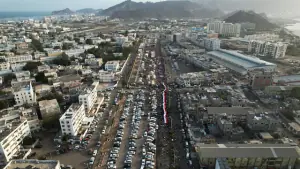Australia floods worsen as thousands more flee Sydney homes
SYDNEY: Torrential rains kept battering Australia’s east coast on Tuesday, intensifying the flood crisis in Sydney as thousands more residents were ordered to leave their homes after rivers swiftly rose past danger levels.
About 50,000 residents in New South Wales, most in Sydney’s western suburbs, have been told to either evacuate or warned they might receive evacuation orders, up from Monday’s 30,000, authorities said.
“This event is far from over,” New South Wales Premier Dominic Perrottet told reporters. “Wherever you are, please be careful when you’re driving on our roads. There are still substantial risks for flash flooding.”
Prime Minister Anthony Albanese, who returned to Australia Tuesday after a week-long trip to Europe, said he would tour the affected regions on Wednesday along with Perrottet.
The federal government has declared the floods a natural disaster, helping flood-hit residents receive emergency funding support.
The latest wild storm cell - which brought a year’s worth of rain in three days to some areas - is likely to ease in Sydney from Tuesday as the coastal trough moves north, the Bureau of Meteorology (BoM) said.
But the risk of flooding could remain through the week with most river catchments already near capacity even before the latest deluge. Some regions have received 800mm (31.5 inches) of rain since Saturday, eclipsing Australia’s annual average rainfall of around 500mm (20 inches).
About 90mm (3.5 inches) of rain could fall over six hours in the state’s mid-north coast from Tuesday, reaching up to 125mm (5 inches) in some places, BoM said.
Winds up to 90 km per hour (56 miles per hour) are also forecast in several flood-hit places, raising the risk of falling trees and power lines.
Battling rough seas, emergency crews continued their rescue operation on Tuesday to tow a bulk carrier ship that lost power off Sydney’s coast after tow lines broke in severe weather, officials said.
Major flooding is occurring at Windsor in Sydney’s west, its third and most severe flood this year, according to the weather bureau.
Footage on social media showed submerged roads and bridges, while emergency crews rescued stranded people from partially submerged vehicles that became stuck in rising waters.
Nigel Myron, a Windsor resident, said he has kept an inflatable boat ready if he had to evacuate though he is looking to move back to his place once waters recede.
“At the end of the day, what can you do? It is what it is and we dust ourselves off from the ashes and rebuild after the floods have come and gone,” Myron told ABC television.
Substantial economic impact
Federal Treasurer Jim Chalmers warned the economic impact from the floods “will be substantial”.
Floods have likely inundated several food-producing regions and that would hit supplies and lift prices, further straining family budgets already reeling under soaring prices of vegetables and fruits, Chalmers said.
“There’s no use tiptoeing around that … that inflation problem that we have in our economy will get worse before it gets better. It’s got a lot of sources, but this (flood) will be one of them,” Chalmers told Sky News.
The Reserve Bank of Australia flagged the floods “are also affecting some prices” as it raised its cash rate a hefty 50 basis points on Tuesday and flagged more tightening ahead to tame surging inflation. read more
The Insurance Council of Australia, which declared the floods a ‘significant event’, urged affected people to apply for claims, even though the full extent of damage was unknown now.
For the latest news, follow us on Twitter @Aaj_Urdu. We are also on Facebook, Instagram and YouTube.





















Comments are closed on this story.